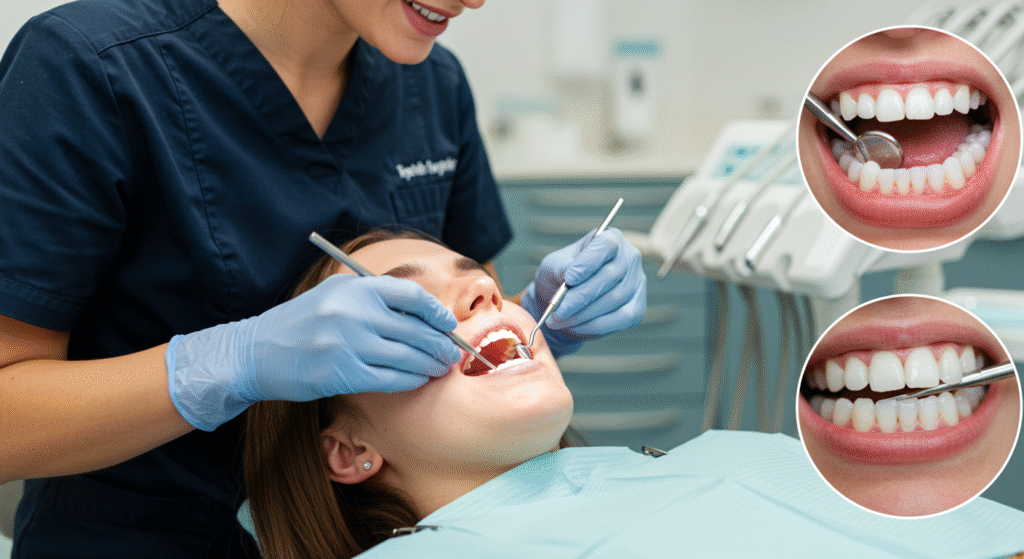Why This Question Matters
You’ve carved out an hour between work calls, considered squeezing in that overdue dental cleaning—and then the question pops up: “How long does a dental cleaning even take?”
You’re not alone. Many patients hesitate to book cleanings because they don’t know how much chair time it requires. Dental cleanings are crucial for oral health, yet the perceived inconvenience—even if minor—can cause unnecessary delays.
Here’s the good news: with updated data, modern workflows, and AI‑enabled dentistry, you can plan with confidence—and in many cases be pleasantly surprised at how efficient a cleaning can be.
In this guide, you’ll discover:
- The average and range of cleaning durations in 2024–2025
- A step‑by‑step breakdown of what happens at your appointment
- Key factors that make cleanings longer (or shorter)
- How tech and AI are accelerating the process
- FAQs with straight-to-the-point answers
- A practical prep checklist to keep your visit smooth
By the end, you’ll have solid expectations—and maybe even look forward to your next cleaning (or at least dread it less).
How Long Does a Typical Dental Cleaning Take in 2024–2025?
Most standard dental cleanings (prophylaxis) take about 30 to 60 minutes. That’s consistent with decades of reports, and new 2024–2025 surveys confirm this range.
But there’s nuance: more complex cleanings (gum disease cases, heavy tartar buildup, or added diagnostics) can exceed 60 minutes or be split across multiple visits.
For example, a 2023 UK survey found the time to complete root surface debridement—a key part of deep cleaning—was ~30 minutes per quadrant depending on clinician experience. That’s in addition to exams and anesthetic, meaning the whole appointment can stretch past 90 minutes.
Here’s a practical planning guide:
| Situation | Typical Duration* |
|---|---|
| Routine prophylaxis cleaning | 30–60 minutes |
| Deep cleaning (scaling and root planing) | 60–90+ minutes, sometimes across 2 visits |
| Periodontal maintenance | ~45–60 minutes |
| Children’s cleaning (simple case) | 20–40 minutes |
| First‑time patient visit | 45–75+ minutes |
*Approximate estimates; real times vary based on individual factors covered below.
What Happens During a Dental Cleaning?
While the basics haven’t changed much over the decades, innovations now make each step more efficient. Here’s how a typical visit flows:
| Step | What Happens | Typical Time Estimate |
|---|---|---|
| 1. Initial Examination & Charting | Hygienist or dentist inspects gums, notes findings, reviews history. | 5–10 min |
| 2. X-rays / Imaging (if needed) | Digital radiographs or intraoral scans (now faster with modern systems). | 3–10 min |
| 3. Scaling (Plaque & Tartar Removal) | Using ultrasonic/manual scalers above the gum line. | 10–30 min |
| 4. Root Debridement / Subgingival Cleaning (if needed) | Below-gum cleaning for gum pockets. | 10–30+ min |
| 5. Polishing | Polishing paste smooths enamel, removes stains. | 3–7 min |
| 6. Flossing | Hygienist clears interproximal areas. | 3–5 min |
| 7. Fluoride/Sealant (optional) | Varnish, gel, or sealants, often in kids. | 2–5 min |
| 8. Dentist Exam & Recommendations | Dentist reviews findings, makes recommendations. | 5–10 min |
👉 For most healthy patients, the whole process stays under an hour. If you need deeper cleaning or special add‑ons, expect around 75 minutes.
What Factors Make a Cleaning Longer or Shorter?
Several variables impact how long you’ll be in the chair. The biggest ones:
- Amount of Tartar/Plaque Buildup – Heavy buildup = more scraping.
- Gum Disease – Pocket depth and inflammation extend cleaning time.
- New Patient Status – First visits involve medical history, imaging, and orientation.
- Anxiety or Sensitivity – More breaks, topical anesthetic, or gentle pacing.
- Mouth Anatomy – Crowding, braces, or restorations = extra steps.
- Technology Used – Offices with ultrasonic scalers, AI‑assisted imaging, and digital workflows finish faster.
- Team Efficiency – Coordinated staff shave 5–10 minutes off.
- Added Treatments – Sealants, desensitizers, or whitening add time.
How New Technology & AI Are Speeding Up Cleanings (2024–2025)
Modern dental care is undergoing an efficiency upgrade. Some highlights:
- Ultrasonic & Piezoelectric Scalers – Remove tartar quickly and more comfortably than hand scaling alone.
- Faster Digital Imaging – Radiographs that once took 10–15 minutes now take under a minute, with instant rendering.
- AI-Powered Diagnostics – 2025 studies show AI reduces time by quickly analyzing radiographs for caries, bone loss, or periodontal disease. This lowers waiting time before scaling begins.
- Predictive Scheduling – Some AI systems now forecast cleaning lengths per patient, improving time allocation.
- Patient Tech (IoT toothbrushes) – Home tech improves oral hygiene, cutting tartar accumulation and shortening necessary cleaning time.
How to Make Your Cleaning Appointment Faster (Without Rushing Care)
Want to streamline your visit? Use this playbook:
- Brush and floss consistently—less plaque = less chair time.
- Stick to your 6‑month (or recommended) interval—avoids buildup.
- Fill out your forms ahead of arrival.
- Arrive early and relaxed—saves scramble minutes.
- Mention sensitivity or gag reflexes in advance—allows hygienist prep.
- Stay calm and minimize “wiggling”—cooperation speeds procedures.
- Schedule when you’re not rushed (avoid back‑to‑back deadlines).
Quick Patient Checklist
✅ Brush/floss the night before and morning of appointment
✅ Bring insurance card and updated medication list
✅ Come 10–15 min early
✅ Wear comfortable clothes
✅ Plan for about an hour
✅ Mentally note areas of concern to discuss with your provider
FAQs: Fast Answers for 2025
Can a cleaning take less than 30 minutes?
Yes, if buildup is minimal and no extras are required. Children often finish in under 30. Adults usually average longer.
Why does mine always take an hour?
It often means you’re getting a thorough cleaning or require extra imaging—both positives for prevention.
Is a deep cleaning the same as a regular cleaning?
No. Deep cleaning reaches below the gumline (scaling and root planing), while prophylaxis focuses above the gums.
How often should I have a cleaning?
Standard: every 6 months. Gum disease patients: every 3–4. Low‑risk patients may stretch to annual visits, depending on dentist’s advice.
Can I eat afterward?
Yes, unless you had fluoride varnish—then wait about 30 minutes.
Do cleanings hurt?
Not usually. Some mild soreness can follow, especially with gum inflammation. Hygienists can adjust or use numbing gels if needed.
Does skipping cleanings affect whole-body health?
Yes. Periodontal inflammation is linked to higher systemic inflammation. For example, a 2025 study associated skipped interdental care with elevated C‑reactive protein (CRP) levels—a marker tied to cardiovascular risk.
Final Thoughts: That Hour is an Investment
So how long does a dental cleaning take today? For most adults: 30 to 60 minutes. If gum disease or extra care is needed, expect a bit longer.
The key takeaway: that hour you invest not only keeps your smile bright—it’s powerful preventive medicine for your whole health. With better technology, skilled hygienists, and smart scheduling, cleanings are faster, more comfortable, and more impactful than ever.
Smile at the thought: in about the time it takes to watch your favorite TV episode, you can walk out of the dentist with cleaner teeth, fresher breath, and a big step toward long-term health.

